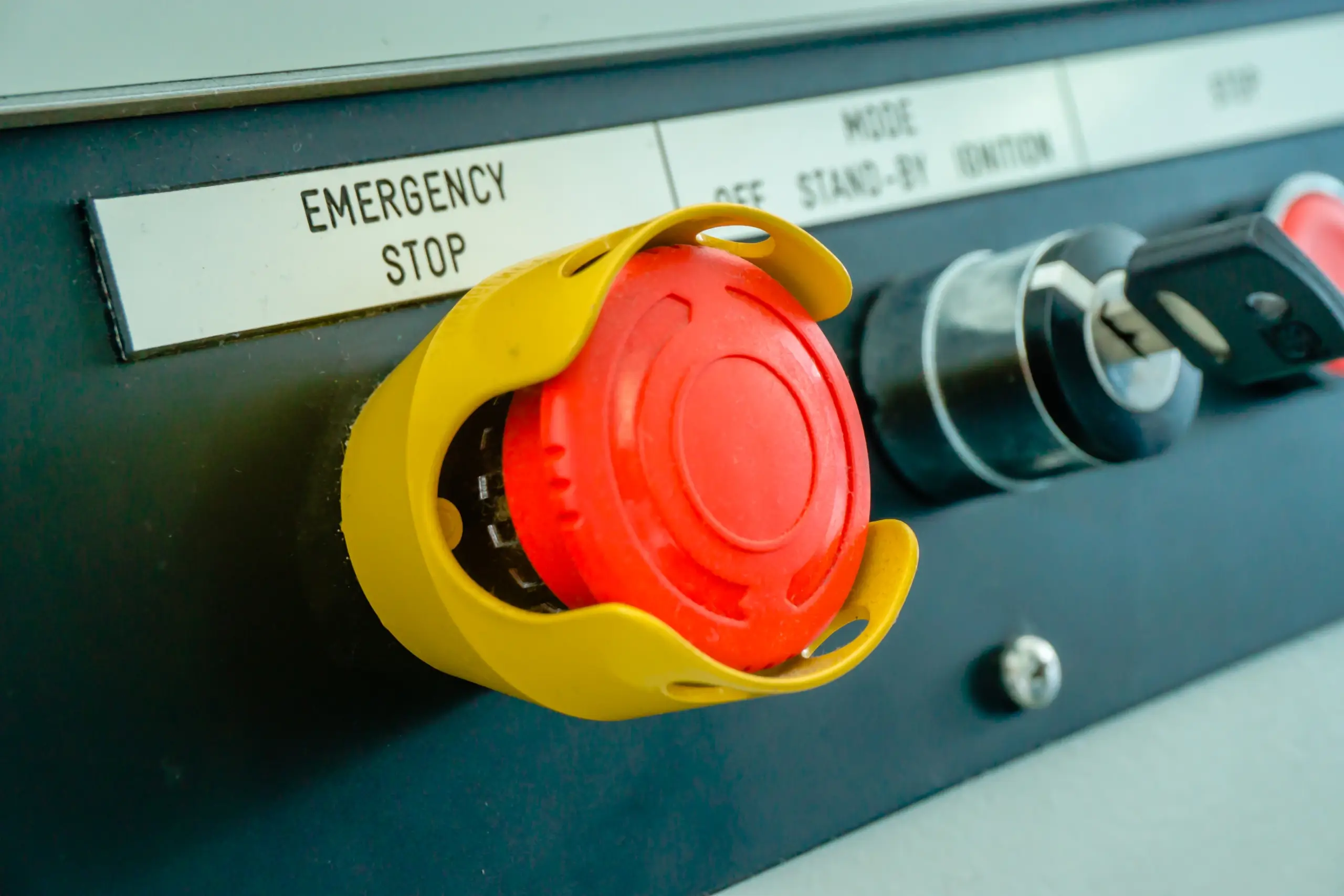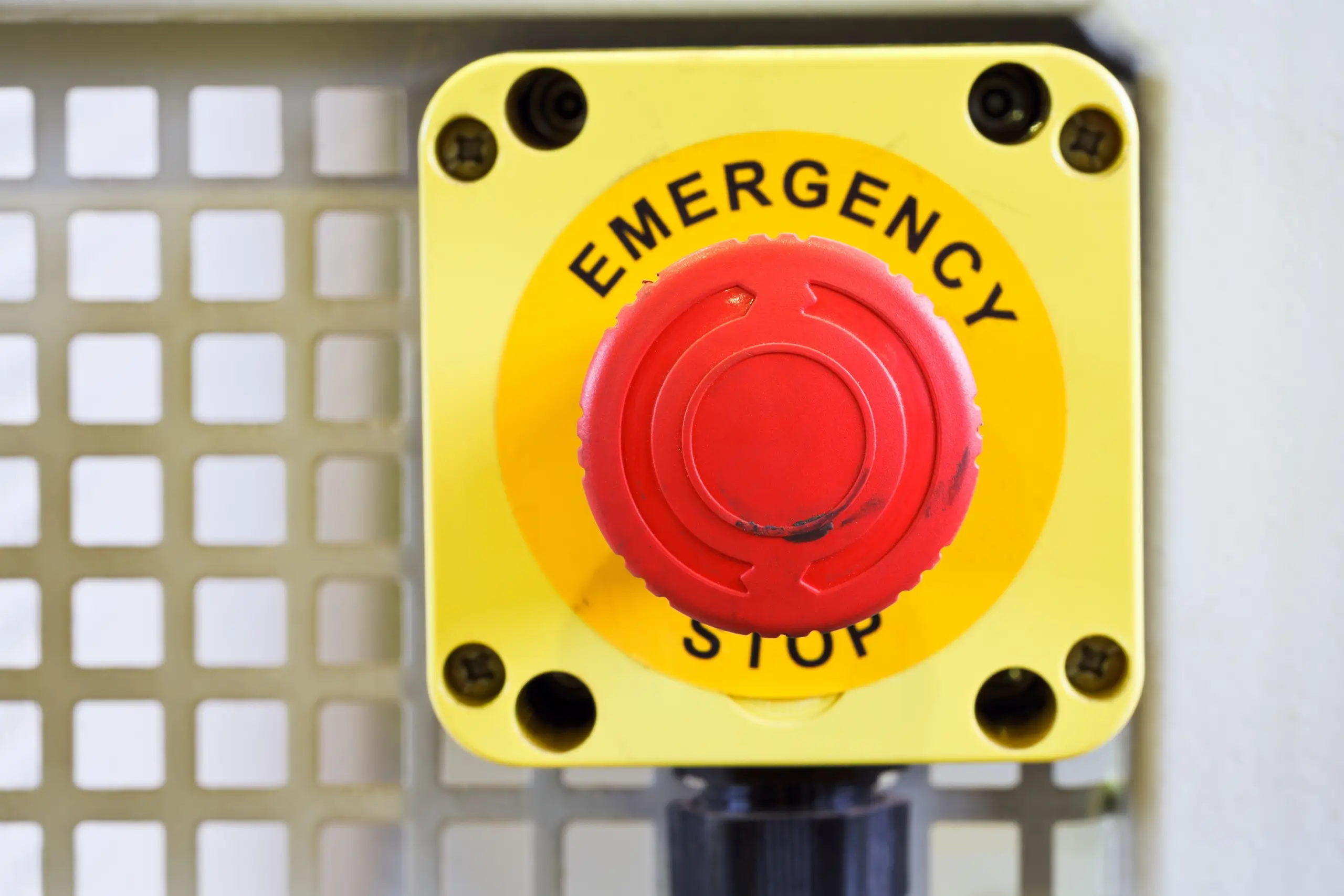In high-risk environments, every second matters. When machinery malfunctions or a worker is in danger, there must be a fast and unmistakable way to stop operations immediately. That’s where the Emergency Stop Button Sign comes in—a critical safety tool designed not only to prevent accidents but also to save lives.
This guide breaks down the meaning, importance, and strategic placement of emergency stop button signs. Whether you’re managing a factory floor, a workshop, or a lab, this information will help you stay compliant, reduce risk, and build a culture of proactive safety.
What Is an Emergency Stop Button Sign?
An Emergency Stop Button Sign is a safety sign that marks the location of an emergency stop mechanism—a red push-button or pull-cord that instantly cuts off power or halts operations when pressed.
The sign uses standardized visual cues: typically a red button symbol on a yellow background with text like “Emergency Stop” or the symbol ⛔️. Its purpose is to guide people to the stop control quickly, even under stressful conditions.

Why Emergency Stop Button Signs Matter
Emergency Stop Button Signs play a critical role in workplace safety. They do much more than just label a button—they guide quick action when every second counts. Here’s why they’re so important:
1. Enable Fast, Life-Saving Action
In an emergency—such as a machine malfunction, entrapment, or chemical spill—workers must act immediately. A clearly visible sign helps them instantly locate the emergency stop button, minimizing injuries and stopping potential disasters in seconds.
2. Compliance with Safety Laws and Standards
Regulatory bodies like OSHA, ISO, and ANSI require proper signage for emergency systems. These signs help organizations comply with legal safety standards, avoiding fines, shutdowns, or legal consequences during inspections or accidents.
3. Create a Visibly Safer Environment
When workers see well-placed, professional safety signs, it sends a message: “This company takes safety seriously.” It boosts employee confidence, encourages responsibility, and helps build a culture of safety.
4. Prevent Equipment and Property Damage
Beyond personal injuries, emergency stops can prevent machinery breakdowns, fires, or hazardous spills. A sign that guides someone to stop equipment in time can save thousands in repair and downtime costs.
5. Universal Understanding in Diverse Workforces
Emergency stop button signs use standardized colors and symbols (red button on yellow background) that are recognized internationally. This ensures that even non-native speakers or visitors can respond quickly and appropriately in an emergency.
In short, these signs turn a critical safety feature into an accessible, visible, and usable tool—making workplaces safer for everyone.

Where Should Emergency Stop Button Signs Be Placed?
Proper placement of emergency stop signs ensures they serve their intended purpose. Here’s how to get it right:
Visibility Is Key
- Signs should be at eye level and in unobstructed view from typical operating positions.
- Avoid placing signs behind equipment, pillars, or moving machinery.
- Use high-contrast colors and consider reflective materials for poorly lit areas.
Position Near the Stop Device
- Always mount the sign directly above, below, or next to the emergency button.
- Maintain a clear path from all sides so any worker can reach it quickly.
Height Guidelines
- According to best practice, emergency stop devices should be installed between 0.6 meters (24 inches) and 1.7 meters (67 inches) above the floor level.
- Ensure the sign is visible from standing and crouching positions.
Uniformity Across the Facility
- Consistency reduces confusion. Use the same design and placement rules for every emergency stop in your facility.
Maintain and Inspect Regularly
- Damaged, faded, or dirty signs should be replaced immediately.
- Add emergency stop checks to your routine safety inspections.

How to Choose the Right Emergency Stop Button Sign
Choosing the correct Emergency Stop Button Sign is essential for ensuring it grabs attention, communicates clearly, and complies with safety regulations. A poorly designed or misplaced sign can delay emergency response—and that can cost lives. Here’s how to pick the right one:
1. Follow Recognized Standards
Choose signs that comply with international safety standards such as:
- ISO 7010 – Defines universal symbols for safety signs.
- ANSI Z535 – Specifies formatting, colors, and wording for U.S. safety signage.
These standards ensure your sign is legally compliant and easily understood, even by workers who speak different languages.
2. Use the Correct Colors and Symbols
Emergency stop signs should use:
- A red circular button symbol to indicate emergency activation.
- A yellow background for high visibility and hazard association.
- Optional bold text like “EMERGENCY STOP” in white or black for added clarity.
These color combinations are internationally recognized and signal urgency immediately.
3. Choose Durable, High-Visibility Materials
- For indoor use, opt for rigid plastic or laminated vinyl.
- For outdoor or industrial environments, use weatherproof materials like aluminum or UV-coated plastics.
- In low-light areas, use reflective or photoluminescent (glow-in-the-dark) signs to maintain visibility during power outages or emergencies.
4. Make Sure the Size Matches the Distance
The sign should be readable from where workers typically stand or operate machinery. A general rule:
- At 3–5 meters away, use signs at least 200mm x 300mm (8″ x 12″) in size.
- For larger facilities, consider bigger signs or adding directional arrows if the button isn’t immediately in view.
5. Include Clear Pictograms and Simple Language
For best results, choose signs that combine:
- Pictograms (standardized button symbol)
- Minimal, bold text (e.g., “Press to Stop” or “Emergency Stop”) This combination ensures quick comprehension, even under stress.
6. Mounting Options
Ensure the sign you choose is compatible with your mounting needs:
- Wall-mounted
- Machine-mounted
- Hanging signage for overhead visibility
Use pre-drilled holes, adhesive backing, or magnetic mounts depending on your surface type and workplace conditions.
Reassess your signs regularly. Replace any that are faded, damaged, outdated, or no longer meet new safety standards. A good sign today could become a hidden hazard tomorrow if it loses visibility or clarity.
In short: The right Emergency Stop Button Sign is standard-compliant, highly visible, easy to understand, durable, and placed exactly where it’s needed. Don’t just meet the minimum—make sure your sign performs when it matters most.

Examples of Emergency Stop Button Sign Use
In factories with automated assembly lines, CNC machines, or robotic arms, emergency stop signs are mounted on control panels and at operator stations. If a machine jams or a worker gets caught, the sign guides them straight to the button to halt operations instantly.
Example: A worker notices a tool left on a conveyor belt. The sign helps them quickly find and press the E-stop before the tool causes a jam or injury.
Chemical Plants and Laboratories
Emergency stop signs are placed near chemical mixers, fume hoods, or processing tanks to stop operations during a spill or reaction overload.
Example: A lab technician sees a chemical bubbling unexpectedly in a reactor vessel. They use the sign-marked button to cut power and initiate emergency protocols.
Warehouses and Distribution Centers
On automated sorting systems, lifts, or conveyor belts, signs mark emergency stops to prevent crush injuries or stop misrouted packages.
Example: A box tips over on a high-speed belt and risks falling onto a worker below. The nearby sign shows where to stop the system safely.
Workshops and Tool Rooms
In areas with drills, lathes, and cutting tools, signs help operators or nearby personnel shut down equipment if a tool malfunctions or someone is at risk.
Example: A lathe begins to vibrate uncontrollably due to a loose part. The operator spots the emergency stop sign and presses the button to avoid damage or injury.
Public Transportation Systems
Emergency stop signs are used on escalators, metro platforms, and automated gates to stop movement and protect passengers.
Example: An item or foot gets caught in an escalator tread. A bystander sees the emergency stop sign and quickly halts the escalator to prevent further harm.
Construction Sites with Machinery
Signs are mounted near cranes, hoists, or hydraulic equipment to stop movement if someone is at risk or a fault is detected.
Example: A crane’s load swings dangerously close to scaffolding. The spotter uses the emergency stop button, clearly marked with a sign, to freeze the crane.
Wherever automated or hazardous equipment is present, Emergency Stop Button Signs provide an immediate, lifesaving point of control. Their presence ensures that workers, operators, and bystanders know exactly where to go in an emergency—no hesitation, no confusion.





